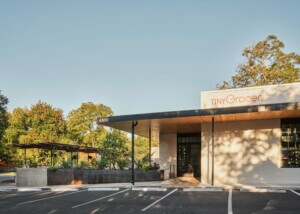Aluminum composite panels have been making headlines of late for all the wrong reasons. The subject of scourge was at the heart—or rather, outer edges—of the Grenfell Tower disaster in the U.K. that saw a fire take the lives of an estimated 80 people as flames traveled via the building’s aluminum composite cladding. However, at Facades+ AM conference in Austin yesterday morning, the material was shown in a new light.
As part of the opening discussion panel, titled Digital Design and Fabrication Frontiers, principal at OTA+, Kory Bieg demonstrated how aluminum composite panels can be used to make three-dimensional structures such as arches and vaults. Speaking to The Architect’s Newspaper (AN), Bieg described how he used parametric design tools such as the Kangaroo plugin for Grasshopper to design Caret 6.
The vaulting structure, designed and fabricated by his Design V Studio at the University of Texas at Austin School of Architecture, was part of an exhibition on metal structures in 2013. Caret 6 is comprised of large folded panels and responds to a brief that called for a structure using aggregation, weaving, and stacking techniques to create an assembly that could transition from a flat surface to a volumetric enclosure.
Bieg benefitted from using Robot Structural Analysis which enabled him to model and test different Aluminum Composite Panel configurations to find the optimum structural solution. “Ultimately, we added a layer of attachment details that included thousands of O-rings and binder rings to ensure stability in the event a lateral force or unexpected point load is applied (ie. someone hanging on the edge of the cantilever), but in its resting state, Caret 6 does not require any fasteners,” the firm said.
Bieg was joined by Anthony Birchler of fabrication firm Zahner. “Digital manufacturing plays an enormous role in not only what we do, but the changing landscape of architecture and design fields,” he said speaking to AN. “Designers want to understand how they can interface with a firm like Zahner—and here’s the big part—they need to know how to establish this kind of precedent with their clients in our industry. Our presentation shows how firms are accomplishing unique architectural works. This isn’t theoretical. This is our practice, and we want to show you how you can do this kind of work”










